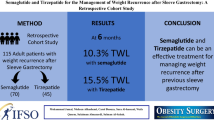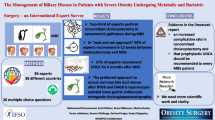Abstract
Background
Patients undergoing bariatric surgery with a gastric bypass lose about 66% of excess weight. Although this procedure induces weight loss, it is unknown whether it leads to protein malnutrition, which is studied here.
Methods
One hundred ten obese patients (body mass index, 47.9 ± 8.6 kg/m2) undergoing gastric bypass had a measurement of plasma albumin and transthyretin (formerly prealbumin) and a calculation of nutritional risk index (NRI) before and throughout the 2 years following the surgery.
Results
All but five patients lost more than 15% of initial weight; the mean loss of excess weight was 65.2 ± 26.4% at 2 years. Plasma concentrations of albumin and transthyretin decreased after surgery, but while albumin returned to initial values after 12 months, transthyretin remained low. Only one patient had an albumin below 30 g/l; another one had a transthyretin lower than 110 mg/l. All NRI scores were lower than 83.5 (62 ± 5, ranging 44–70), qualifying patients for severe malnutrition.
Conclusion
Malnutrition is difficult to diagnose in obese patients undergoing surgery. The large weight loss is most often not associated with protein malnutrition. Whether gastric bypass induces protein malnutrition remains to be established.

Similar content being viewed by others
References
Enquête épidémiologique nationale sur le surpoids et l’obésité. 2006 http://www.roche.fr/portal/eipf/france/rochefr/institutionnel/o-pa.
Fried M, Hainer V, Basdevant A, Bariatric Scientific Collaborative Group Expert Panel, et al. Interdisciplinary European guidelines for surgery for severe (morbid) obesity. Obes Surg 2007;17:260–70.
Sjöström L, Lindroos AK, Peltonen M, Swedish Obese Subjects Study Scientific Group, et al. Lifestyle, diabetes, and cardiovascular risk factors 10 years after bariatric surgery. N Engl J Med 2004;351:2683–93.
Sjöström L, Narbro K, Sjöström CD, Swedish Obese Subjects Study, et al. Effects of bariatric surgery on mortality in Swedish obese subjects. N Engl J Med 2007;357:741–52.
Buchwald H, Avidor Y, Braunwald EJ, et al. Bariatric surgery a systematic review and meta-analysis. JAMA 2004;292:1724–37.
Perry CD, Hutter MM, Smith DB, et al. Survival and changes in comorbidities after bariatric surgery. Ann Surg 2008;247:21–7.
Marceau P, Biron S, Hould FS, et al. Duodenal switch: long-term results. Obes Surg 2007;17:1421–30.
Lee CW, Kelly JJ, Wassef WY. Complications of bariatric surgery. Curr Opin Gastroenterol 2007;23:636–43.
Faintuch J, Matsuda M, Cruz ME, et al. Severe protein-calorie malnutrition after bariatric procedures. Obes Surg 2004;14:175–81.
Alvarez-Leite JI. Nutrient deficiencies secondary to bariatric surgery. Curr Opin Clin Nutr Metab Care 2004;7:569–75.
Scopinaro N, Marinari GM, Camerini G. Laparoscopic standard biliopancreatic diversion: technique and preliminary results. Obes Surg 2002;12:241–4.
Lönroth H. Laparoscopic gastric bypass. Obes Surg 1998;8:563–5.
Buzby GP, Williford WO, Peterson OL, et al. A randomized clinical trial of total parenteral nutrition in malnourished surgical patients: the rationale and impact of previous clinical trials and pilot study on protocol design. Am J Clin Nutr 1988;47(2Suppl):357–65.
Lorenz RG, Hardy RW. Performance of the Sebia CAPILLARYS 2 for detection and immunotyping of serum monoclonal paraproteins. Am J Clin Pathol 2007;128:293–9.
Lievens M, Bienvenu J, Buitrago JMC, et al. Evaluation of four new Tina-quant assays for determination of alpha-1-acid glycoprotein, alpha-1-antitrypsin, haptoglobin and prealbumin. Clin Lab. 1996;42:515–20.
Bistrian B. Systemic response to inflammation. Nutr Rev 2007;65(12 Pt 2):S170–2.
Bistrian BR. Dietary treatment in secondary wasting and cachexia. J Nutr 1999;129(1S Suppl):290S–4S.
Norman K, Pichard C, Lochs H, Pirlich M. Prognostic impact of disease-related malnutrition. Clin Nutr 2008;27:5–15. Feb.
Corti MC, Guralnik JM, Salive ME, Sorkin JD. Serum albumin level and physical disability as predictors of mortality in older persons. JAMA 1994;272:1036–42.
Sullivan DH, Walls RC. Impact of nutritional status on morbidity in a population of geriatric rehabilitation patients. J Am Geriatr Soc 1994;42:471–7.
Visser M, Kritchevsky SB, Newman AB, et al. Lower serum albumin concentration and change in muscle mass: the Health, Aging and Body Composition Study. Am J Clin Nutr 2005;82:531–7.
Reinhardt GF, Myscofski JW, Wilkens DB, et al. Incidence and mortality of hypoalbuminemic patients in hospitalized veterans. J Parenter Enteral Nutr 1980;4:357–9.
Naber THJ, de Bree A, Schermer TRJ, et al. Specificity of indexes of malnutrition when applied to apparently healthy people: the effect of age. Am J Clin Nutr 1997;65:1721–5.
Naber THJ, Schermer T, de Bree A, et al. Prevalence of malnutrition in nonsurgical hospitalized patients and its association with disease complications. Am J Clin Nutr 1997;66:1232–9.
Le Moullac B, Gouache P, Bleiberg-Daniel F. Regulation of hepatic transthyretin messenger level during moderate protein and food restriction in rats. J Nutr 1992;122:864–70.
Shetty PS, Watrasiewicz KE, Jung RJ, James WPT. Rapid turnover transport proteins: an index of subclinical protein-energy malnutrition. Lancet 1979;2:230–2.
Ferguson RP, O’Connor P, Crabtree B, et al. Serum albumin and prealbumin as predictors of clinical outcomes of hospitalized elderly nursing home residents. J Am Geriatr Soc 1993;41:545–9.
Baxter JP. Problems of nutritional assessment in the acute setting. Proc Nutr Soc 1999;58:39–46.
Genton L, van Gemert W, Pichard C, Soeters P. Physiological functions should be considered as true end points of nutritional intervention studies. Proc Nutr Soc 2005;64:285–96.
Ritz P, Sallé A, Audran M, Rohmer V. Comparison of different methods to assess body composition of weight loss in obese and diabetic patients. Diabetes Res Clin Pract 2007;77:1085–9.
Author information
Authors and Affiliations
Corresponding author
Rights and permissions
About this article
Cite this article
Ritz, P., Becouarn, G., Douay, O. et al. Gastric Bypass is not Associated with Protein Malnutrition in Morbidly Obese Patients. OBES SURG 19, 840–844 (2009). https://doi.org/10.1007/s11695-008-9627-3
Received:
Accepted:
Published:
Issue Date:
DOI: https://doi.org/10.1007/s11695-008-9627-3




